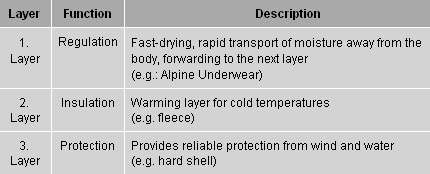Layering principle
| Layering principle | |
|---|---|

To enable mountaineers to actively regulate their body temperature, they need to wear different layers of clothing. The thinner these layers, the more precise the regulation. If the layers are properly coordinated, they can work interactively with each other. |
|
| Three layers | |
 |
|
| 5 basic rules for an effective layering system | |
|
|
| Soft shell revolution | |
| Soft shells are revolutionising the classic "onion layering" or multiple layer principle by combining the second and third layers - creating a garment that offers both temperature regulation and weather protection. Soft shell garments are highly abrasion-resistant, elastic and wind-resistant, as well as offering enduring water and dirt repellent properties. They provide sufficient protection from wind and weather to cope with around 90% of all weather conditions. |






